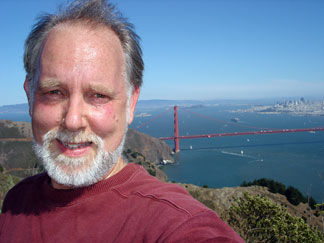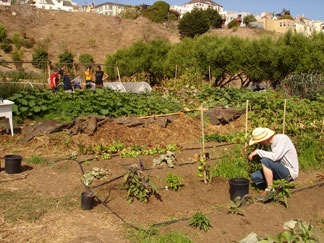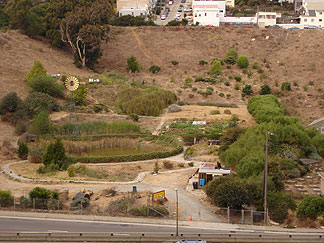I’ve taken to big bike rides up the steepest hills around. Lately, I’ve been heading to the top of Twin Peaks a couple of times a week, up and down Potrero Hill, McLaren Park, Bernal Heights, Nob Hill and even Hawk Hill. Here’s a photo I took standing at the top of Hawk Hill in the Marin Headlands, after a great ride over Pacific Heights, up and over the Presidio, and then the bridge.
It’s a great workout, not just for my ever thickening body, but my head too. Riding through the city for a few hours, taking weird routes up steep hills, I always find new pleasures, odd views, strange happenings. I even went to the Cable Car museum the other day, which I’d never done.
Heading up to Twin Peaks is my most common ride. It’s a big surprise: once you get up all the steep blocks (like 25th between Hoffman and Grand View, then Clipper to the top–that’s serious!) and then find your way to Twin Peaks Blvd., you are suddenly out of the city. It’s quiet, the aliens close in (eucalyptus, french broom, german ivy and a bunch more) and the hum of local insects rises with the sun’s heat, or on some days, with the swirling fog. It’s magical. The city is far away, glimpses of it surround you, but you’re above it, floating away in an altogether “natural” space. And yet, on a clear day, I’m checking in with the whole town, first the haze over the bay beyond Mission Bay and downtown, then the southern reaches of the city with San Bruno Mountain looming in the distance, the west side with its boxy landscape stretching to the sea, Sutro Tower standing like a 19th century apparition out of H.G. Wells, views to the north reveal that red bridge poking out of rolling hills, citified until the bulging green Presidio, brown and dry across the gate… At the top at last, sweaty and refreshed, Market Street’s diagonal draws our attention back to the heart of the city.
So my natural health club, in which the whole city is my gym, is giving me a workout, though perhaps ‘fat farm’ is a bit extreme. But to fulfill my silly pun I recently visited a really “Phat” farm, the Alemany gardens. Here’s a couple of shots:
As a subtheme of my ongoing writing project these days, I’ve started talking to gardeners and other urban ecologists about the prospects for us to feed ourselves from within San Francisco. Of course, we probably can’t totally feed ourselves, but at the end of WWII, the city was getting about 45% of its fresh produce from some 70,000-odd “victory gardens.” Clearly, if we converted a substantial amount of the land wasted accommodating parking and moving cars we could alter the terms of the discussion. Maybe that’s not going to happen in the next few months or even the next few years.
Still, the folks at the Alemany garden represent to me a new wave of city dwellers who are starting to practice a radical alternative in the here and now. Their efforts, while still in the nascent stage, are trying to create a real basis for self-sufficiency in this formerly sandy peninsula. Add in a major dose of permacultural science to help “grow” soil, convert our relationship to the aquifer, the creeks buried in our sewers, and the rain that falls on us only to run off into the gutters, we could dramatically enrich and localize our food and water self-sufficiency. This is the stuff of a real new politics, still largely invisible even to folks who feel connected to radicalism.
I just saw an awesome movie a second time, “The Real Dirt on Farmer John“, which underscores the most difficult part of the urban agricultural fantasy described above. It’s a movie that I cannot recommend highly enough, for its amazing honesty and completely surprising story. But within it is a cautionary tale about how much work is involved in growing organic food. Farmer John, like one of the farmers I recently saw at the Occidental Arts and Ecology Center, works somewhere in the range of 80 hours a week routinely. If it takes that kind of intensive labor to convert to a more self-sufficient system of food production, we are going to have some real problems finding a lot of people to join us. I’m very intrigued by the promises of permaculture and biodynamic agriculture, but the key question of labor-intensivity is far from solved.
A discussion to be continued, but anyway, riding up steep hills is surprisingly enjoyable… and sure beats the hell out of paying some gross company to use their smelly, alienated facilities full of isolated people struggling to regain or improve their health by spinning on treadmills.















=v= Hey, that’s my old route up and over Twin Peaks, though I’ve also been known to take scenic detours through the terraced side streets. Definitely good for what ails you.
I remember once, years ago, when Critical Mass went up Twin Peaks (via a more leisurely route). The sun was just setting, and there were numerous couples up there just waiting for the relative privacy one has in a car in the darkness, when all of a sudden they were surrounded by hundreds of people and bikes. Whoops. :^)
No worries, Bob, I did not think you were making accusations… but let’s face it, I really *ought* to be able to point to my source for such a big and interesting claim… so I keep searching.
Rocco, I’m a wimp! a full 18 speeds makes those hill climbs possible, but no longer the 63 speeds I once tooled around with… Haven’t tried Fillmore yet, but now that you’ve reminded me, I’m going to go do it!
Do you take the aforementioned hills on the Critical Mass bike?? A single-speed if I recall correctly. If so, three cheers!! The glory of city riding and seeking out formidable hills is a hobby of mine as well, but even with my “fancy” new road bike I could not take Twin Peaks all the way. And I must admit, the Fillmore Street hill (the one they do EIGHT times in the SF Grand Prix), well I did not even attempt it this past Saturday. And I am riding 100+ miles a week now!!
I didn’t mean to imply that you would make that up – I’m asking because I want to know more.
Hi Bob,
Sheepishly I have to admit that after a vigorous half hour search through my library, I cannot find the source. I thought it was in John Brucato’s “A Sicilian in America” which has a wonderful account of the Victory Garden movement in WWII (confirming the 70,000 number), but I could not find anything about the percentage of food derived from them… So, I must have read it somewhere along the way, because I wouldn’t make that up. But danged if I can find it now. I’ll keep looking…
Hey, Chris-
I’ve seen you cite that 45% figure before, and it astounds me (in a good way). Where does it come from?